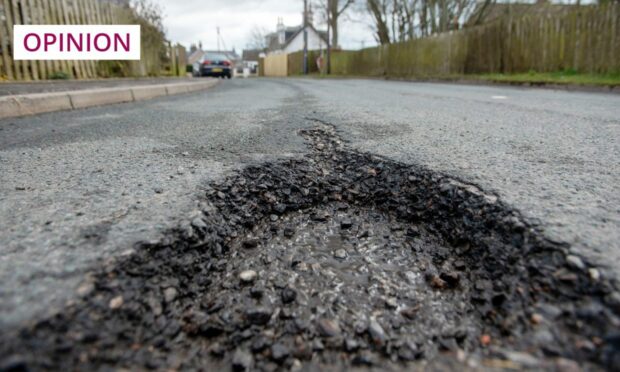I remember the first time I heard A Day in the Life by The Beatles, from the album which changed the world for music lovers.
The lyrics were mind-bending, like many other hallucinogenic songs on Sgt Pepper’s Lonely Hearts Club Band. But two threads of reality collided in the middle.
It’s still a shock today to hear Lennon and McCartney singing about a tragic sudden death caused by a car crash in one verse, and then about how there were “4,000 holes in Blackburn, Lancashire” in the next.
When the next general election comes around, the song will be almost 60 years old. But it strikes a chord in our everyday lives.
After all, the SNP crisis looks like a political car crash. And there are still a lot of potholes around – 10,000 repaired in Scotland recently. So many, in fact, that the gaping craters pockmarking our roads are a regional emergency in the Highlands and north-east.
It should be at the top of new transport secretary Kevin Stewart‘s in tray. Around £600,000 would make a dent in solving the problem, but where do you find that kind of cash these days?

Stewart is, of course, an Aberdeen MSP. There is a road near me which I’m pretty sure is in his Aberdeen Central constituency; I drove along it the other day.
Actually, to describe it as “driving” would be an exaggeration. I edged along, as though I were in a minefield. But it gave me time to count two things: the number of potholes, and the uneven, ugly scars left behind by roadworks, zigzagging from side to side.
The road was only a couple of hundred yards long, but my tally of these twin hazards came to a grand total of 52.
It could be mistaken for an old wartime training camp, where soldiers practised throwing live hand grenades and digging tunnels in case they became prisoners of war. A developing country would turn its nose up at this.
I have to say, though, in the interest of balance, that there was something on this sad and neglected road to marvel at as an impressive feat of engineering quality: concrete speed ramps which also crisscrossed the highway. They, at least, had lasted the test of time, as everything else crumbled around them.
So, if the potholes don’t wreck your car – or luxury motorhome, for that matter – the speed ramps will.
To be honest, the pothole crisis is so bad, we don’t need ramps anymore to stop us driving too fast. Maybe this is the solution to bring down traffic accidents: allow our roads to become strangled by potholes to stop us moving.
It seems the SNP threw away its chance
Giving CPR to the SNP must be like sliding into a big, black pothole. The party is like a limp balloon after the puff has gone, or time slipping away on a life-support machine.
I wonder what happens the next time they make an appeal for tons of public cash for a referendum? Not that this is going to happen anytime soon, by the looks of it. Many of those who donated to the fighting fund now under police investigation might have passed on by then.
Far be it from me to jump to any conclusions about what happened to the £600,000 the public gave the SNP to fund dreams of a second independence referendum. But, whatever the outcome, people could be less than enthusiastic about supporting the party’s fundraising for years to come. It’s only human nature, isn’t it? Especially as party bosses are still struggling to find auditors brave enough to verify their books.
I once asked an SNP spin doctor if the party could rule forever, unchallenged, as a nationalist force fighting Scotland’s corner. The conversation happened after an off-the-record political dinner for SNP bigwigs and media, during the run up to the 2014 referendum.
For a brief moment, the advantage seemed to have shifted behind the Yes campaign; independence loomed, and Alex Salmond’s fingertips were almost on the prize.
The spin man smiled and replied: “Of course not. Like Thatcher and Blair, people will tire and start judging our record of achievement over the years.”
So, when Humza Yousaf says this is a chance for a fresh start, to tackle all the pressing domestic issues the previous SNP administration – the one he was a key part of – failed at so abysmally, isn’t it a bit rich? Surely they had their chance and threw it away?
But Yousaf is busy clambering back on Sturgeon’s broken-down gender recognition reform bandwagon. And doubts remain about his legitimacy as leader, with calls for a leadership race re-run and questions about the strangely truncated campaign period.
The stars are not aligning well for the new leader – or maybe a pile of political potholes will end his progress.
David Knight is the long-serving former deputy editor of The Press and Journal



Conversation